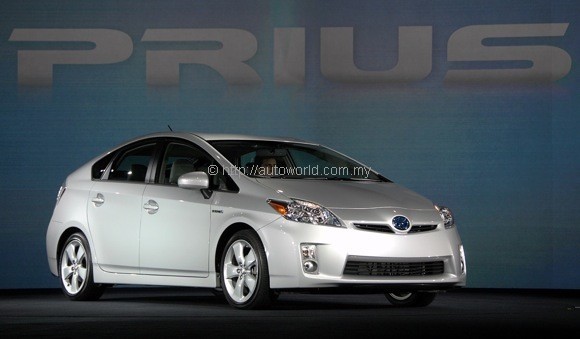New Japan-market ‘Prius’ Gets World’s Best Fuel Efficiency
Tokyo — TOYOTA MOTOR CORPORATION (TMC) announces that the
Japanese-market version its third-generation “Prius” gasoline-electric hybrid vehicle has achieved the best fuel efficiency in the world1 for a mass-produced vehicle, as measured using the 10-15 test cycle of the Japanese Ministry of Land, Infrastructure, Transport and Tourism (MLIT). The achievement represents part of TMC’s numerous and ongoing efforts to improve fuel efficiency through advanced vehicle development.
The new Prius, scheduled for launch in Japan in mid-May, has a fuel efficiency of 38.0km/l (CO2 emissions: 61g/km), thus exceeding by more than 25% the mandatory level required under the 2010 national standards. Also, under MLIT’s newer JC08 test cycle, the vehicle has a fuel efficiency of 32.6km/l (CO2 emissions: 71g/km), thereby already meeting the 2015 national standards.
Emissions of both nitrogen oxides and non-methane hydrocarbons have also been reduced in the new Prius, with levels 75% lower than the 2005 standards under the MLIT’s approval system for low-emission vehicles, which is currently the strictest standard in Japan for emissions.
As such, under the Japanese government’s taxation system for environmentally friendly vehicles, the new Prius is exempt from the
automobile weight tax (until April 30, 2012), is exempt from the automobile acquisition tax (until March 31, 2012) and qualifies for a 50% reduction in the automobile tax (until March 31, 2010).
Editor’s Note:-
It will be interesting to see what will be the selling price of the Prius when it is launched here. The Civic Hybrid is currently offered at RM129K.
Also interesting would be what I call ‘real world’ consumption figures for both models. The fact that the Prius comes with a 1.8 litre engine indicates it has more horsepower to start with, but how does it affect absolute costs like sen per kilometre. Would-be users will be looking at price versus size and capacity, and absolute fuel economy. Whilst test figures are a good basis for comparison, it’s the real world that counts.
1 Compared to other gasoline-powered passenger vehicles; as of March 2009, as surveyed by TMC


























